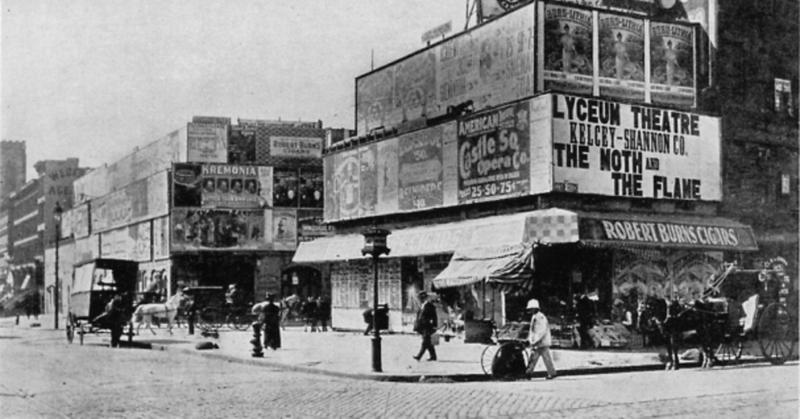Times Square History: The Weird Story Of The Evolution Of New York's Tourist Mecca
By | December 28, 2020

Anyone who visits New York City is bound to make their way to Times Square, the mecca of tourism in the Big Apple. Once the scene of unbridled debauchery, the hot spot has since been sanitized in more ways than one, but Times Square hasn't always been a collection of blocks teeming with tourists and lit by massive LED screens.
Started From The Bottom (Of A Horse)
Originally nothing more than a farm, the area initially played host to the Manhattan manor of John Morin Scott, a general fighting under George Washington. Scott used the area for breeding horses, a fate that stuck with it long after the land was sold off to various real estate concerns by John Jacob Astor.
What was left of Scott's farm came to be known as Longacre Square even though it was shaped more like a bow tie or two intersecting triangles than anything else. As late as 1872, the area was known as the hub of the horse carriage industry, but the horses—and their smell—remained into the early 20th century. Manure and all manner of animal waste lined the streets, but German businessman Oscar Hammerstein I saw something in Longacre that nobody else did, if only because they couldn't bear to look for too long.

Paving The Great White Way
In 1895, Hammerstein brought a new kind of business to this world of horses and carriages: theater. He developed the Olympia, a huge entertainment complex meant to light a fire in the hearts of the opera lovers of the city. His ingenuity inspired more patrons of the arts to move in, and they took up every spot for a block on 42nd Street.
At the same time that theaters were moving into the area, so were brownstone buyers, bordellos, and small-time crooks. It wasn't yet "Slime Square," but as the horsing industry moved out and the entertainment industry moved in, a cast of seedy characters holed up in the middle of the city that never sleeps.

Newspapers And New Years
When Adolph S. Ochs, publisher of the New York Times, moved his newspaper to a building on 42nd Street, the area quickly became known as Times Square. Once the first electric ad went up in the square in 1904, it was clear that all eyes were soon to be on this small patch of Manhattan. As more people and businesses moved into the area, so did advertisers, with Wrigley's renting the largest space in the world at the time for $9,000 per month.
Soon after, in 1907, people began gathering in Times Square to celebrate the new year with the drop of an illuminated ball made out of iron and wood that weighed 700 lbs. Times Square sign maker Artkraft Strauss constructed this ball and every one for a century after, and even after the New York Times moved out of the square in 1914, the celebrations continued.

Slime Square
Once the stock market crashed in the 1929, the entire world was sunk into a harrowing miasma, and New York City was at its center. Residents barely had the money to feed themselves, let alone take in a show, so many of the businesses in the square either shuttered for good or pared down until they were almost nothing. Theaters closed due to low attendance, and in their place sprung up saloons and brothels.
Along with those less-than-savory businesses came less-than-savory tenants, which led to a "reputation for licentiousness." Crime and black markets blossomed in the area, and even after post-war stability brought good vibes back to the city, Times Square remained a neighborhood filled with seedy bars, adult theaters, and an air of violence that throbbed through Manhattan. By the 1970s, crime and drug use was so rampant in Times Square that pamphlets circulated throughout the city instructing tourists to take cabs rather than risk their lives walking through the area. Rolling Stone referred to Times Square as the "sleaziest block in America," and in 1984, 2,300 crimes took place within the single block, most of them felonies like murder and rape.

Giuliani's New York
In an attempt to crack down on crime in the '90s, Mayor Rudolph Giuliani swept the city with a figurative but mighty broom. He was determined to exterminate the criminal element that had taken root in the Big Apple, specifically Times Square, turning it into a family-friendly place where tourists from across the world could feel safe and the only threats to their wallets were chain restaurants and souvenir shops.
Aside from shutting down the porn shops and triple-X arcades and pushing dealers and junkies out of Times Square, Giuliani fined New York City bars and nightclubs for not registering "cabaret licenses." The police officers in his employ handed out tickets for everything from dancing to smoking to poorly lit exit lights. The clean up worked, and the city's violent crime rate dropped by 56%.

Times Square Today
Today, Times Square is the antithesis of what we think about when we think about New York City. There are no hipsters walking the streets looking for a hot new underground restaurant, the uber wealthy of the city don't dirty their shoes with its sidewalks, and anyone looking for a "real" New York experience avoids the area like the plague, but tourists and businesses flock to the site to take their own bite of the Big Apple. Times Square now brings in $2.5 billion in tax revenue to the city and $2.3 billion to the state, essentially the equivalent of the entire economic output of Nashville, Tennessee, and it's visited by 50 million tourists every year.

